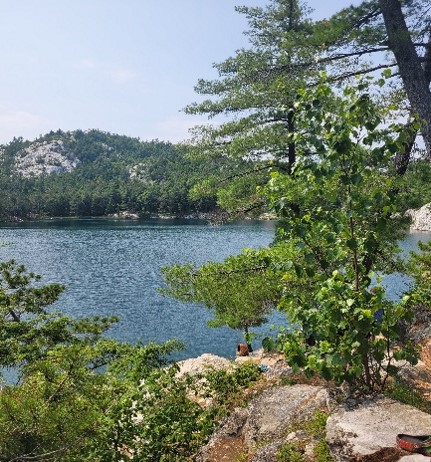Study shows Lake Kagawong’s fluctuations not their doing
KAGAWONG—Residents of Billings Township were told during a public meeting held recently that low ware levels in Lake Kagawong are not caused by Oakville Enterprises Corporation (OEC), the company that operates the hydroelectric dam on the Kagawong River.
If OEC was not running the hydro power generating plant on the Kagawong River in Billings Township, water levels would still drop close to the minimum lake level every summer, said an OEC representative.
“If the power plant was not there, levels would still be dropping close to the rule curve (212.66 metres above sea level),” said Bill Touzel, of OEC, at a public meeting last week.
Lake Kagawong covers an area of 55 square kilometres. “If there was zero inflow to the lake from the other 185 kilometres of the watershed area (a very unlikely scenario), then operating the generating station at maximum output would lower the lake level by 0.5 centimetres (one-fifth of an inch) per day, or 3.5 centimetres or 1.4 inches per week,” said Mr. Touzel.
Losing one-fifth of one inch of water per day adds up over the course of the summer but there is more water lost due to evaporation than from power plant operations, he said. Evaporation, leakage, and flow through the dam all impact lake level.
Billings Mayor Bryan Barker said in comparing water levels this summer with last summer, he didn’t see much difference. “I want to communicate that it’s not just hydro generation that affects the levels,” he said. “In the spring, the township is responsible for mitigating the flood levels as well.”
Ontario’s Ministry of Natural Resources and Forestry (MNRF) approves and administers the Kagawong Watershed Management Plan (WMP), Mr. Touzel said. “We are required to maintain the level of Lake Kagawong and flows in the Kagawong River, in accordance with the WMP. It is an offence under provincial law not to do so. MNRF makes it quite plain that flood control and ecological protection trump all other factors related to levels and flows. The only exemptions from this obligation are if Mother Nature makes it either impossible or unsafe to meet the requirements.”
WMP requirements include a maximum lake level of 213.12 metres above sea level (masl) year-round, a minimum lake level of 212.66 masl from January 1 until the peak of freshet each spring and also from September 15 to December 31.
Between the peak of freshet and September 15, the minimum daily level is derived by drawing a rule curve line (on the annual levels graph) between 213.07 masl and continuing downward to 212.66 masl on September 15. The station is not allowed to operate if the lake is below minimum and flow must be maintained over Bridal Veil Falls at no less than 0.4 cubic metres per second, primarily for ecological reasons, regardless of lake level.
Water to power the turbine is drawn off the Kagawong River via a canal before water plunges over the falls.
Lake Kagawong water levels approach 212.66 every summer. OEC is required to read the water level gauge twice a week. “We read the gauge,” Mr. Touzel said. “We’re not in the business of lying to anyone.”
There are leaks in the rock from the falls from the pathway to the base of the lake, noted resident Brian Parker. He said there was talk at one point of culverting the canal.
“This station generates a quarter of a million dollars in gross revenue per year,” responded Mr. Touzel. He said revenues to Billings Township are 23.5 percent of that amount, and culverting the canal would be a multi-million dollar process the generating station couldn’t pay for, and there wasn’t enough water loss to justify it. He said there has always been leakage through the rock into the valley of the river, but under the lease agreement, OEC is responsible for any dam leaks or repairs to the station.
Mr. Parker asked if there was any thought of allowing more water and revising the rule curve. “The water is very low and it’s mid-August,” he said, wondering of 212.66 masl is too low.
“We will have a conversation with MNRF on that,” said Mr. Touzel. “This would mean an amendment to the WMP.”
The MNRF has rarely revisited the upper and lower limits of the rule curve.
Mr. Parker also noted that water use patterns will change worldwide as the climate changes.
“The current thinking (by scientists) is in the mid-North, there will be increased precipitation rates in the next 50 to 100 years,” said Mr. Touzel. “This area may see wetter conditions in the future.”
Bill Begley of OEC said, “The municipality is a good partner to be with. If there are challenges in the future, we’re here 100 years and will for another 100 years. We are not a numbered company. Our takeaway is not very big at all. We’re here for the long haul.”
Since OEC is municipally owned, they understand the concerns of the township, Mr. Begley added.
OEC is a for-profit business that includes several operating companies and is wholly owned by the Town of Oakville. Most OEC companies include renewable energy generation and related support services. It is a sister company to the Oakville Hydro utility.
Billings owns the Kagawong generating station and the primary infrastructure, including the land, dam, powerhouse building, penstock and turbine. OEC leases the station from Billings and is responsible for all operation, maintenance, refurbishment and administration costs, and is obligated to operate in accordance with the Kagawong Water Management Plan under the scrutiny of the Ontario Ministry of Natural Resources and Forestry (MNRF). The permit and licence to operate the station is through the MNRF.
Electricity from the station is sold into the provincial grid under a contract with the province of Ontario. Terms of the contract specify that Billings receives 23.5 percent of the revenue from the sale of electricity. The total annual revenue from 2020 to 2023 averages $246,000 per year, and therefore the township received $58,000 per year on average during that timeframe, with no related expenditures, explained Mr. Touzel.
The $58,000 average received annually by the township amounts to approximately two percent of its tax revenue base. The rate the township receives in annual revenues is about twice what other municipalities get, said Mr. Touzel. “The largest I know in the province is 15 percent, and for 23 percent of the share of revenues, the township doesn’t have to do much as the OEC handles day to day malfunctions, taxes and other expenses. “I think if the municipality was operating (the generating station) itself, the profits would not be (almost) $60,000 per year. This is not a business for the faint of heart.”
“I don’t recommend small municipalities take over these types of operations,” Mr. Touzel said. “You have huge collection problems and the capital investment requirements can overwhelm small municipalities for technical and safety requirements. Legally, Billings could, but I don’t think it would be a good idea and wouldn’t make any money.”
Mayor Barker said he’s been asked why Billings shouldn’t take over the hydro plant and generate their own power. He said the township looked into this last year, looking at three or four other municipalities that operate hydro generation stations, and it wouldn’t be feasible for Billings. The mayor called the public meeting because of misinformation on how hydro generation affects lake levels.





